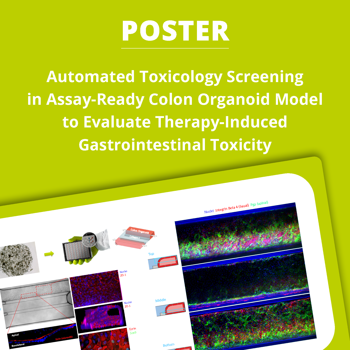Automated Toxicology Screening in Assay-Ready Colon Organoid Model to Evaluate Therapy-Induced Gastrointestinal Toxicity

Gastrointestinal toxicity (GIT) is a common side effect of cancer therapies and other treatments, often leading to dose-limiting complications. Traditional toxicity models fail to replicate the human gut environment, limiting their predictive power.MIMETAS' ready-to-use 3D Colon Organoid model overcomes these limitations by providing a scalable, perfused, and assay-ready microfluidic system that closely mimics human intestinal physiology. This platform enables high-throughput toxicology screening, allowing for accurate evaluation of acute and chronic drug-induced GI toxicity.Key Features of the Model3D human colon organoid tubules – Replicates native intestinal architectureAutomated, high-throughput testing – Supports 40-64 tubules per platePerfusable & membrane-free – Enables apical and basolateral drug exposureBarrier integrity assessment – TEER & viability assays for mechanistic toxicity insightsCompatible with standard lab equipment – Integrates with liquid handling & fluorescence imaging
Automated Toxicology Screening in Assay-Ready Colon Organoid Model to Evaluate Therapy-Induced Gastrointestinal Toxicity

Automated Toxicology Screening in Assay-Ready Colon Organoid Model to Evaluate Therapy-Induced Gastrointestinal Toxicity
An assay-ready 3D colon organoid model for automated, high-throughput screening of drug-induced gastrointestinal toxicity—offering physiologically relevant architecture, perfusion, and mechanistic readouts for accurate toxicity evaluation.

Automated Toxicology Screening in Assay-Ready Colon Organoid Model to Evaluate Therapy-Induced Gastrointestinal Toxicity
An assay-ready 3D colon organoid model for automated, high-throughput screening of drug-induced gastrointestinal toxicity—offering physiologically relevant architecture, perfusion, and mechanistic readouts for accurate toxicity evaluation.

Automated Toxicology Screening in Assay-Ready Colon Organoid Model to Evaluate Therapy-Induced Gastrointestinal Toxicity
An assay-ready 3D colon organoid model for automated, high-throughput screening of drug-induced gastrointestinal toxicity—offering physiologically relevant architecture, perfusion, and mechanistic readouts for accurate toxicity evaluation.

Automated Toxicology Screening in Assay-Ready Colon Organoid Model to Evaluate Therapy-Induced Gastrointestinal Toxicity
An assay-ready 3D colon organoid model for automated, high-throughput screening of drug-induced gastrointestinal toxicity—offering physiologically relevant architecture, perfusion, and mechanistic readouts for accurate toxicity evaluation.

Automated Toxicology Screening in Assay-Ready Colon Organoid Model to Evaluate Therapy-Induced Gastrointestinal Toxicity
An assay-ready 3D colon organoid model for automated, high-throughput screening of drug-induced gastrointestinal toxicity—offering physiologically relevant architecture, perfusion, and mechanistic readouts for accurate toxicity evaluation.

Automated Toxicology Screening in Assay-Ready Colon Organoid Model to Evaluate Therapy-Induced Gastrointestinal Toxicity
An assay-ready 3D colon organoid model for automated, high-throughput screening of drug-induced gastrointestinal toxicity—offering physiologically relevant architecture, perfusion, and mechanistic readouts for accurate toxicity evaluation.

Automated Toxicology Screening in Assay-Ready Colon Organoid Model to Evaluate Therapy-Induced Gastrointestinal Toxicity
An assay-ready 3D colon organoid model for automated, high-throughput screening of drug-induced gastrointestinal toxicity—offering physiologically relevant architecture, perfusion, and mechanistic readouts for accurate toxicity evaluation.

Automated Toxicology Screening in Assay-Ready Colon Organoid Model to Evaluate Therapy-Induced Gastrointestinal Toxicity
An assay-ready 3D colon organoid model for automated, high-throughput screening of drug-induced gastrointestinal toxicity—offering physiologically relevant architecture, perfusion, and mechanistic readouts for accurate toxicity evaluation.

